Panasonic CW-C53HU, CW-C53GK User Manual
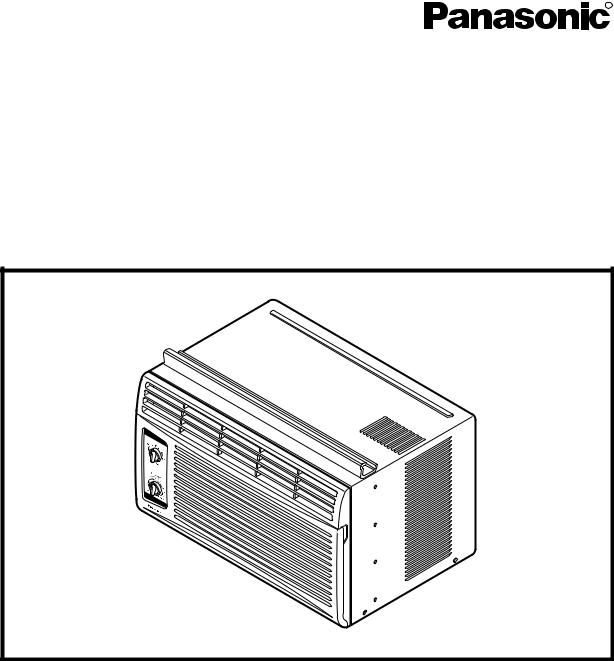
R
Room Air Conditioner
Climatiseur de fenêtre
INSTALLATION AND OPERATING INSTRUCTIONS
MANUEL D'INSTALLATION ET D'UTILISATION
Model, Modèle: CW-C53GK
CW-C53HU
Please read these operating instructions thoroughly before using your air conditioner and keep for future reference.
Il est recommandé de lire attentivement ce manuel avant d'utiliser l'appareil. Conservez ce manuel.
For U.S. customers:
For assistance, please call: 1-800-211-PANA(7262) or
Register your product at : http://www.panasonic.com/register
For customers in Canada :
For assistance, please call : 905-624-5505
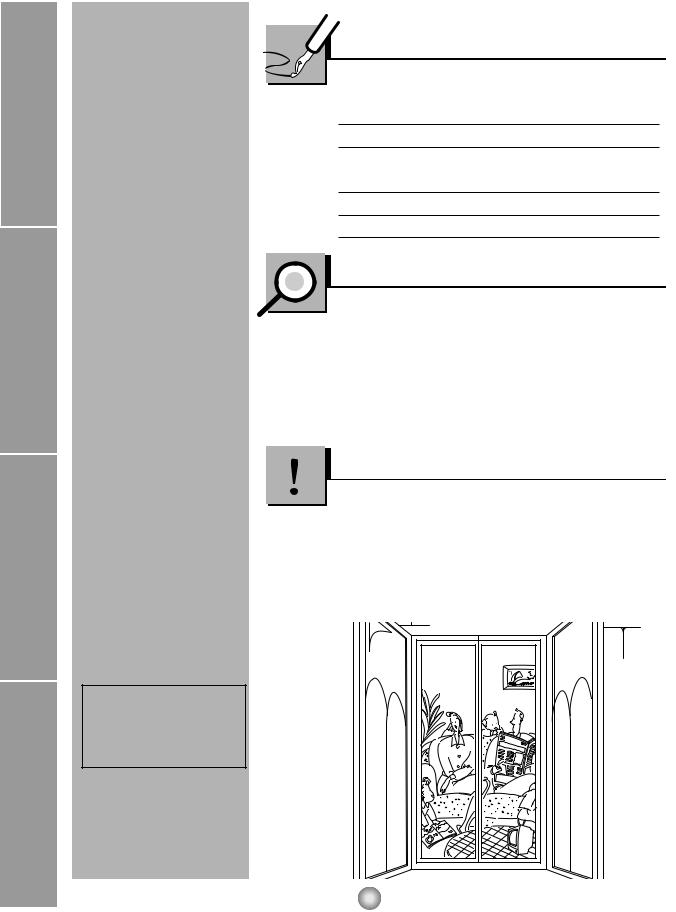
Safety Precautions |
Before you call for service... Features and Installation About the Controls on the Air Conditioner
Safety Precautions
Safety Precautions ............. |
3 |
About the Controls on the Air Conditioner
Controls.............................. |
5 |
Air direction ........................ |
6 |
Care and Maintenance ...... |
6 |
Features |
|
and Installation |
|
Features ............................. |
7 |
Window Requirements ....... |
8 |
Electrical Data .................. |
10 |
Before You Call |
|
For Service... |
|
Normal Operation............. |
11 |
Abnormal Operation ......... |
11 |
FOR YOUR RECORDS
Write the model and serial numbers here:
Model #
Serial #
You can find them on a label on the side of the unit.
Dealer's Name
Date Purchased
Staple your receipt here for proof of purchase.
READ THIS MANUAL
Inside you will find many helpful hints on how to use and maintain your air conditioner properly. Just a little preventive care on your part can save you a great deal of time and money over the life of your air conditioner.
You'll find many answers to common problems in the chart of troubleshooting tips. If you review our chart of Troubleshooting Tips first, you may not need to call for service at all.
CAUTION
•Contact an Authorized Service Center for repair or maintenance of this unit.
•The air conditioner is not intended for use by young children or invalids without supervision.
•Young children should be supervised to ensure that they do not play with the air conditioner.
2
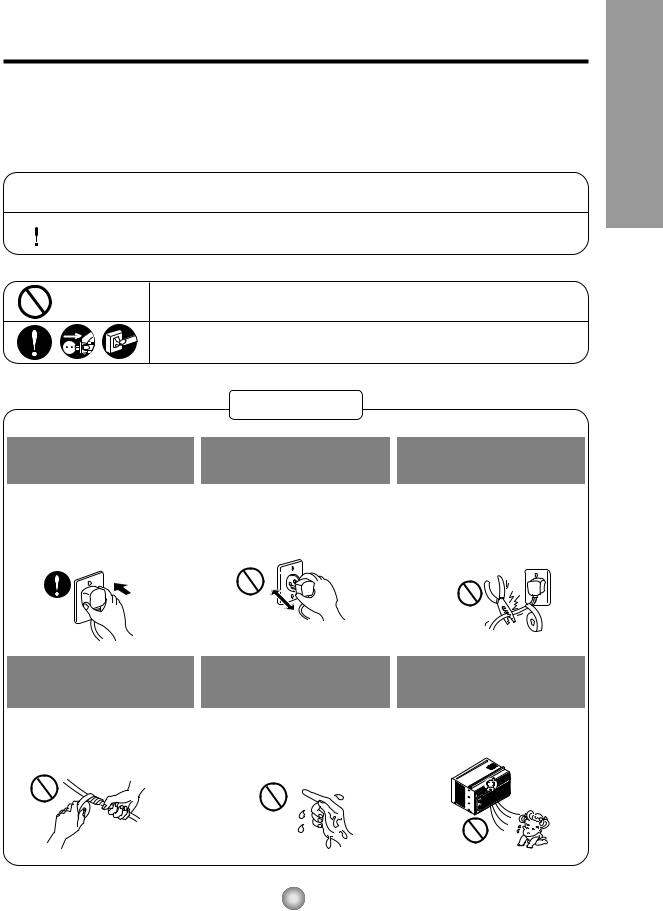
Safety Precautions
To prevent injury to the user or other people and property damage, the following instructions must be followed:
■Incorrect operation will cause harm or damage. The seriousness is classified by the following indications.
■Because of the weight of the product, it is recommended that you have a helper to assist in the installation.
■Use Caution! Sharp Edges! See Warning, page 4.
 WARNING : This symbol indicates the possibility of death or serious injury.
WARNING : This symbol indicates the possibility of death or serious injury.
 CAUTION : This symbol indicates the possibility of injury or damage to property only.
CAUTION : This symbol indicates the possibility of injury or damage to property only.
■ Meanings of symbols used in this manual are as shown below.
Be sure not do this.
Be sure to follow the instructions.
 WARNING
WARNING
Plug in the power plug properly.
•Otherwise, it will cause electric shock or fire due to heat generation.
Do not operate or stop the unit by inserting or pulling out the power plug.
•It will cause electric shock or fire due to heat generation.
Do not damage or use an unspecified power cord.
•It will cause electric shock or fire.
•If the power cord is damaged, it must be replaced by the manufacturer or its service agent or a similarly qualified person in order to avoid a hazard.
Precautions Safety
Do not modify the length of the power cord or use an extension cord.
•It will cause electric shock or fire due to heat generation.
Do not operate with wet |
Do not direct air flow at room |
hands or in a damp |
occupants. |
environment. |
|
• It will cause electric shock. |
• This could lead to health |
|
problems. |
3
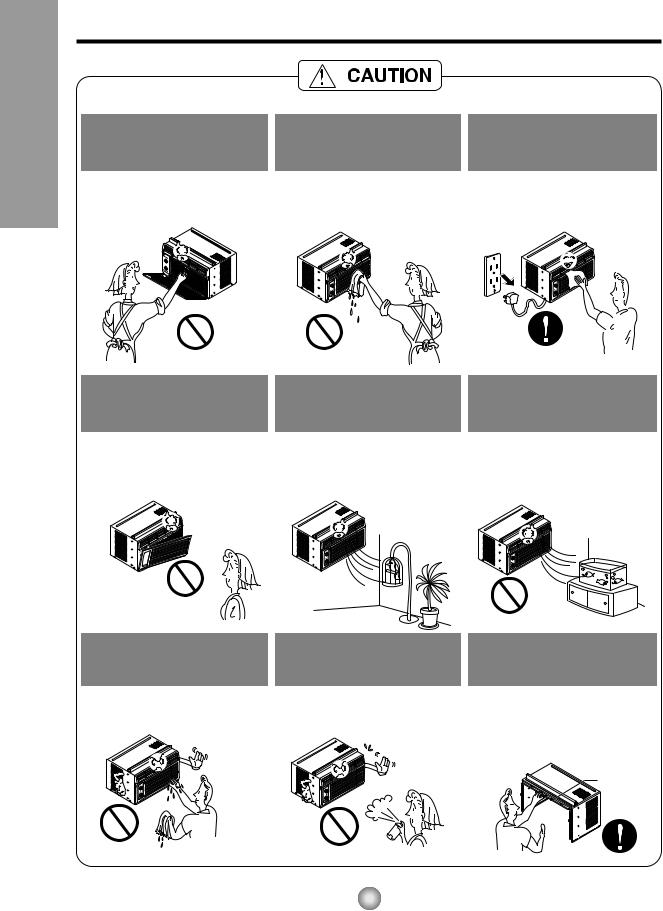
Safety Precautions
When the air filter is to be removed, do not touch the metal parts of the unit.
•They are sharp and may cause an injury.
Do not clean the air conditioner with water.
•Water may enter the unit and degrade the insulation. It may cause an electric shock.
When the unit is to be cleaned, switch the unit off, and unplug it.
•Since the fan rotates at high speed during operation, it may cause an injury.
Do not operate the unit without the air filter or when the front intake grille has been removed.
•It could cause dust to accumulate on the heat exchanger.
Do not put a pet or house plant where it will be exposed to direct air flow.
•This could injure the pets or plants.
Do not use the unit for any other purpose than its intended use.
•Do not use this air conditioner to preserve precision devices, food, pets, plants, or art objects.
It may cause deterioration of quality, etc.
Do not operate switches with wet hands.
• It may cause an electric shock.
Do not apply an insecticide |
SHARP EDGES! |
or flammable spray. |
|
• It may cause a fire or damage of |
• Use caution when handling the |
the cabinet. |
case. Grip it firmly and do not allow |
|
it to slip while holding it. |
|
• Use heavy gloves to handle the |
|
case if necessary. |
|
Sharp edges |
4
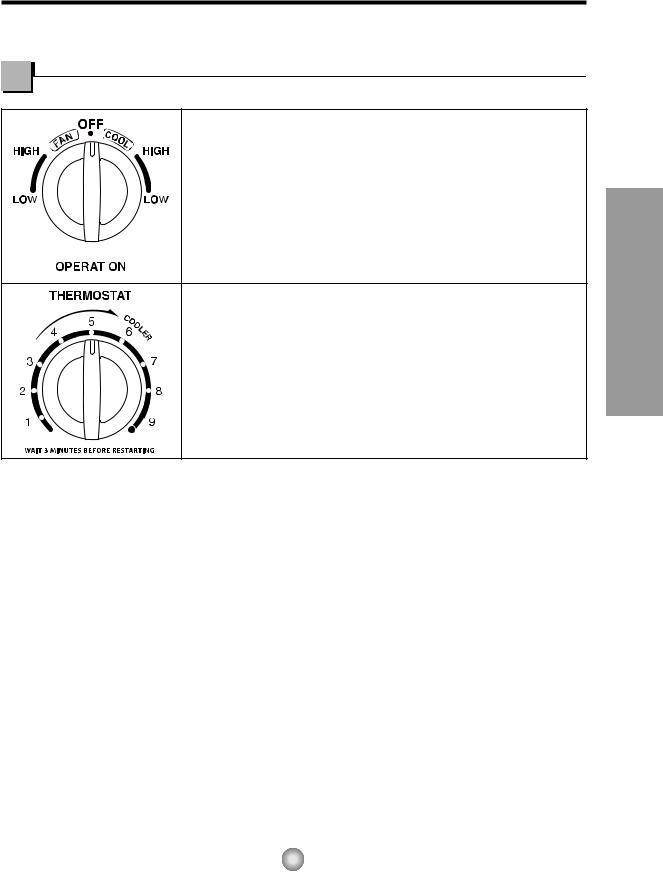
About the Controls on the Air Conditioner
The controls will look like one of the following:
Controls
Off |
- Turns air conditioner off. |
High Fan |
- High speed fan operation without cooling. |
Low Fan |
- Low speed fan operation without cooling. |
High Cool |
- Cooling with high speed fan operation. |
Low Cool |
- Cooling with low speed fan operation. |
|
|
|
|
This automatically controls the temperature of the indoor air.
Turn the knob so that the arrow points to the larger marks for greater cooling.
Point the arrow to the smaller marks for more moderate cooling. (i.e. the higher the number, the greater the cooling)
■FOR NORMAL COOLING
1.Turn the operation switch to the High Cool or the Low Cool setting.
2.Set the thermostat control to the desired temperature mark 5 (the mid-point is a good starting position). If the room temperature is not satisfactory after a reasonable time, adjust the control to a cooler or warmer setting, as appropriate.
■FOR MAXIMUM COOLING
1.Turn the operation switch to the High Cool setting.
2.Set the thermostat control to the highest (9) temperature mark.
■FOR QUIETER OPERATION
1.Turn the operation switch to the Low Cool setting.
2.Set the thermostat control as needed.
■CAUTION
When the air conditioner has performed its cooling operation and is turned off or set to the fan position, wait at least 3 minutes before resetting to the cooling operation again.
Conditioner Air the on Controls the About
5
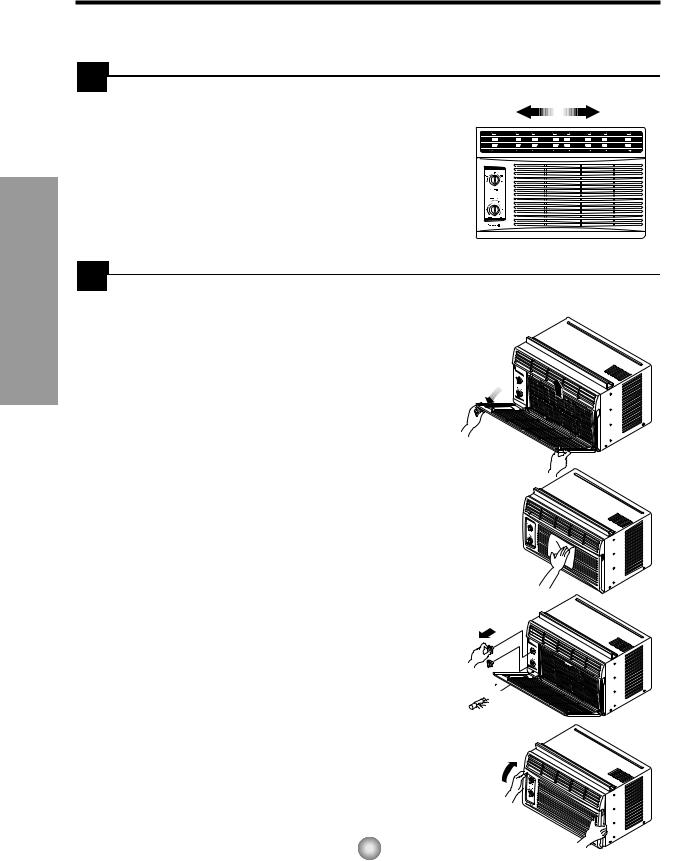
About the Controls on the Air Conditioner
Additional controls and important information.
 Air Direction
Air Direction
• ADJUSTING THE AIR DIRECTION USING THE HORIZONTAL AIR-DEFLECTOR CONTROL
Using the control tabs, the air flow can be directed to the left, right, straight ahead, or any combination
of these directions.
 Care and Maintenance
Care and Maintenance
•TO CLEAN FILTER
The air filter will become dirty as it removes dust from the inside air.
It should be washed at least every 2 weeks. If the air filter remains full of dust, the air flow will decrease and the cooling capacity will be reduced, possibly damaging the unit.
1.Pull the inlet grille forward and pull out the air filter. (Fig. 1)
2.Wash the air filter in warm 104°F (40°C) water. Be sure to shake off all the water before replacing the filter.
•CLEANING THE AIR CONDITIONER
The front grille and inlet grille may be wiped with a cloth dampened in a mild detergent solution. (Fig. 2) The cabinet may be washed with mild soap or detergent and lukewarm water, then polished with
a liquid wax used for appliances.
To ensure continued peak efficiency, the condenser coils (outside of unit) should be checked periodically and cleaned if clogged with soot or
dirt from the atmosphere.
•HOW TO REMOVE THE FRONT GRILLE
1.Remove the thermostat knob and the operation knob by pulling.
2.Remove the screw securing the front grille. (Fig. 3)
3.Push the grille up from the bottom and pull the top of the grille away from the case as the top tabs lift out of their slots. (Fig. 4)
Do not force open or open too
far (about 56° )
Fig. 1
Fig. 2
Fig. 

Fig. 4
6
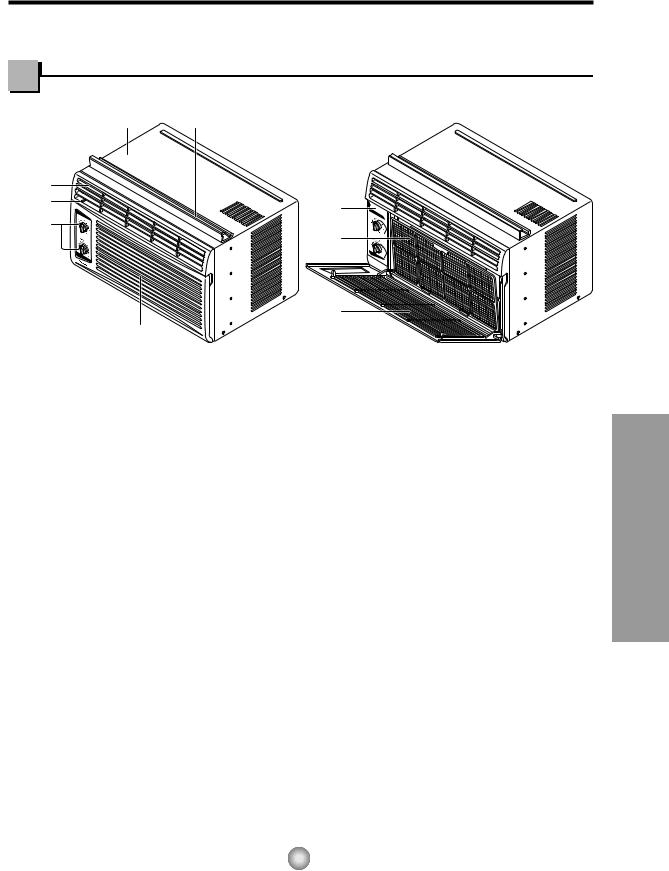
Features and Installation
Learning parts name prior to installation will help you understand the installation procedure.
Features
1 |
9 |
|
3 |
|
|
2 |
4 |
|
7 |
||
6 |
||
|
|
5 |
8 |
|
1. CABINET |
6. AIR FILTER |
2. HORIZONTAL AIR DEFLECTOR |
7. KNOBS |
3. COOL AIR DISCHARGE |
8. AIR INTAKE |
4. FRONT GRILLE |
9. UPPER GUIDE |
5. INLET GRILLE |
|
Installation and Features
7
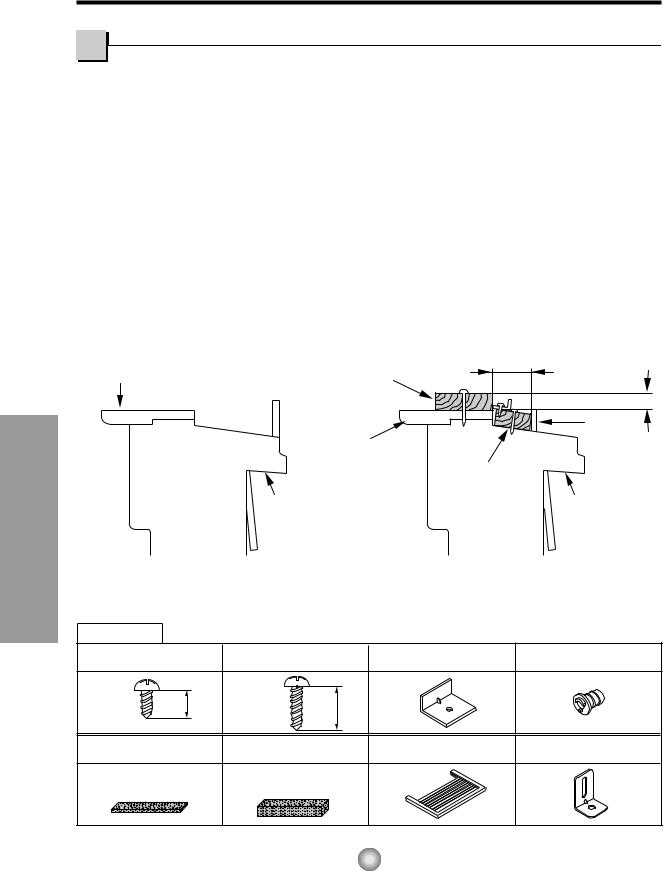
Features and Installation
Window Requirements
NOTE: All supporting parts should be secured to firm wood, masonry, or metal.
1.This unit is designed for installation in standard double hung windows with actual opening widths of 22" to 36". The upper and lower sash must open sufficiently to allow a clear vertical opening of 13" from the bottom of the sash to the window stool.
2.If a storm window presents interference, fasten a 2" wide wood strip to the inner window sill across the full width of the sill. The wood strip should be thick enough to raise the height of the window sill so that the unit can be installed without interference by the storm window frame.
See Fig. 5-2. The top of the wood strip should be approximately 3/4" higher than the storm window frame (STORM WINDOW FRAME) or wood strip (OUTDOORS) to help condensation to drain properly to the outside.
3.Install a second wood strip (approximately 6" long by 11/2" wide and same thickness as first strip) in the center of the outer sill flush against the back off the inner sill. This will raise the L bracket as shown in Fig. 5-2.
4.The thickness of the second wood strip may not be the same as the first wood strip.
The thickness of the second wood strip must be defined to keep the 3/4 inch distance between the inner sill or the top of the first wood strip and the outer sill.
INNER |
WOOD STRIP MOUNTED |
1" |
3/4" |
|
SILL |
ON TOP OF INNER SILL |
|||
|
|
|
|
CLEARANCE |
|
|
|
|
STORM |
|
|
INNER |
|
WINDOW |
|
|
|
FRAME |
|
|
|
SILL |
|
|
|
|
WOOD STRIP |
|
|
|
|
FOR L BRACKET |
|
|
|
OUTER |
|
|
OUTER |
|
SILL |
|
|
SILL |
INDOORS |
OUTDOORS |
INDOORS |
|
OUTDOORS |
|
Fig. 5-1 |
|
Fig. 5-2 |
|
Installation
HARDWARE
TYPE A: 11EA |
TYPE B: 5EA |
TYPE C: 3EA |
DRAIN PIPE |
|
(SHORT SCREW) |
(WOOD SCREW) |
(L BRACKET) |
||
|
||||
10mm |
16mm |
|
|
|
TYPE D: 1EA |
TYPE E: 1EA |
TYPE F: 2EA |
TYPE G: 1EA |
|
(SEAL STRIP) |
(SASH SEAL) |
(GUIDE PANEL) |
(SUPPORT BRACKET) |
|
(Adhesive backed) |
(Not adhesive backed) |
|
|
8

A. BEFORE INSTALLATION
1.Insert the guide panels into the guides of the air conditioner. Fasten the curtains to the unit with screws (TYPE A), as shown Fig. 6.
2.Cut the adhesive-backed seal strip (TYPE D) to the window width.
Remove the backing from the seal strip and attach the seal strip to the underside of the bottom window. (Fig. 7)
B. NOW START INSTALLATION
1. LOCATING UNIT IN A WINDOW
Open the window and mark center line on the center of the inner sill, as shown in Fig. 8.
2.ATTACH L BRACKET
a.Install the L brackets behind the inner window sill, with short side of bracket as shown. Use the 2 screws (TYPE A) provided.
b.The bracket helps to hold the unit securely in place. Be sure to place bracket edge flush against back of inner sill. See Fig. 9.
CAUTION
During the following step, hold unit firmly until window sash is lowered to top channel behind side panel frames. Personal injury or property damage may result if unit falls from window.
3.INSTALL THE AIR CONDITIONER IN THE WINDOW
a.Carefully lift the air conditioner and slide it into the open window. Make sure the bottom guide of the air conditioner drops into the notches of the L bracket. See Fig. 9.
IMPORTANT :
When the air conditioner drops into the L bracket, the air conditioner will be centered in window opening as shown in Fig. 10.
b.While steadying the air conditioner, carefully bring the window sash down behind the upper guide of the air conditioner, as shown in Fig. 11.
9
TYPE A
Fig. 6 |
TYPE A |
|
SEAL STRIP 
 (TYPE D)
(TYPE D)
Fig. 7
CENTER LINE
INNER SILL
ROOM SIDE
Fig. 8
INNER SILL
OUTER SILL |
TYPE A INSIDE |
|
CENTER LINE |
8"
8" 
OUTSIDE
Fig. 9 |
L BRACKET |
|
CENTER LINE
Fig. 10
WINDOW FRAME 

UPPER GUIDE 
 SEAL
SEAL
ABOUT 1/4"
BOTTOM
GUIDE
Fig. 11 |
L BRACKET |
Installation and Features
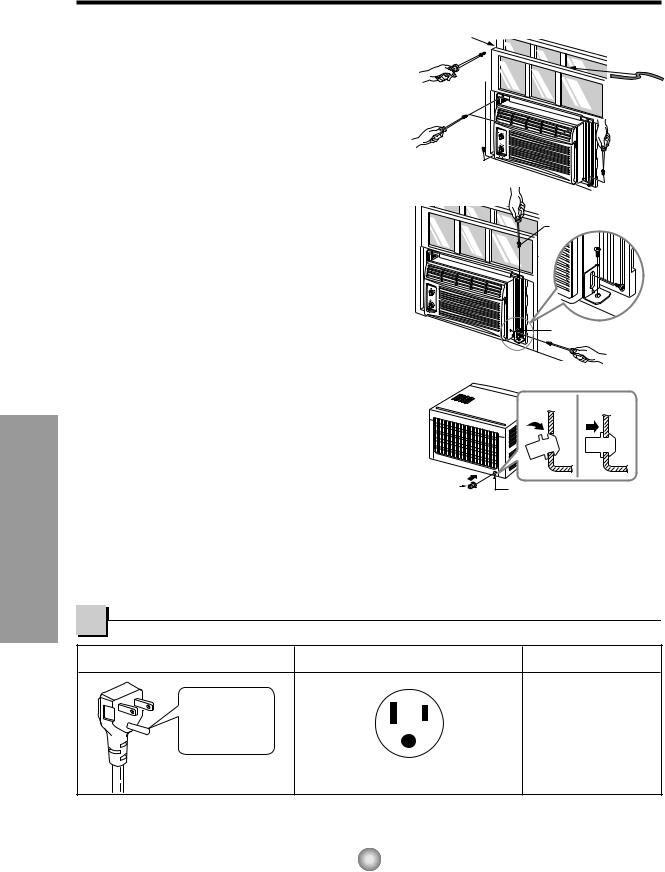
Features and Installation
4. SECURE THE GUIDE PANELS
Extend the guide panels (TYPE F) to fill the window opening using 4 screws (TYPE B) to secure them, as shown in Fig. 12.
5.INSTALL THE SASH SEAL AND SASH LOCK
a.Cut the sash seal (TYPE E) to the window width. Stuff the sash seal between the glass and the window to prevent air and insects from getting into the room, as shown in Fig. 12.
b.Fasten the L bracket using a screw (TYPE A), as shown in Fig. 12.
6.a. Remove the screws that secure the cabinet and base pan in the right side.
b.Fasten the support bracket (TYPE G) using a removed screw. Attach the support bracket (TYPE G) in the inner window sill with a screw (TYPE B), as shown Fig. 13.
7.Window installation of room air conditioner is now completed. See ELECTRICAL DATA for attaching power cord to electrical outlet.
L BRACKET
TYPE A 


TYPE B |
Fig. 12
TYPE B
SASH SEAL (TYPE E)
Support Bracket (TYPE G)
Fig. 13
C. HOW TO SECURE THE DRAIN PIPE
In humid weather, excess water may cause the BASE PAN to overflow. To drain the water, remove the DRAIN CAP and secure the DRAIN PIPE to the rear hole of the BASE PAN. (Fig. 14) Press the drain pipe into the hole by pushing down and away from the fins to avoid injury.
 Hang
Hang  Push
Push
DRAIN PIPE |
DRAIN CAP |
Fig. 14
REMOVAL FROM WINDOW
Turn the air conditioner off, disconnect the power cord, remove the Support Bracket, L bracket and the screws installed through the top and bottom of the guide panels, and save for reinstallation later. Close the guide panels. Keeping a firm grip on the air conditioner, raise the sash, and carefully tilt the air conditioner backward, draining any condensate. Lift the air conditioner from the window and remove the sash seal from between the windows.
Electrical Data
Line Cord Plug |
Use Wall Receptacle |
Power Supply |
Do not under any |
|
|
circumstances cut |
|
Use 15 AMP, time |
or remove the |
|
|
grounding prong |
|
delay fuse or circuit |
from the plug. |
|
breaker. |
|
|
|
Power supply cord with |
Standard 125V, 3-wire grounding |
|
3-prong grounding plug |
receptacle rated 15A, 125V AC |
|
USE OF EXTENSION CORDS
Because of potential safety hazards, we strongly discourage the use of an extension cord. However, if you wish to use an extension cord, use a CSA certified/UL-listed 3-wire (grounding) extension cord, rated 15A, 125V.
10
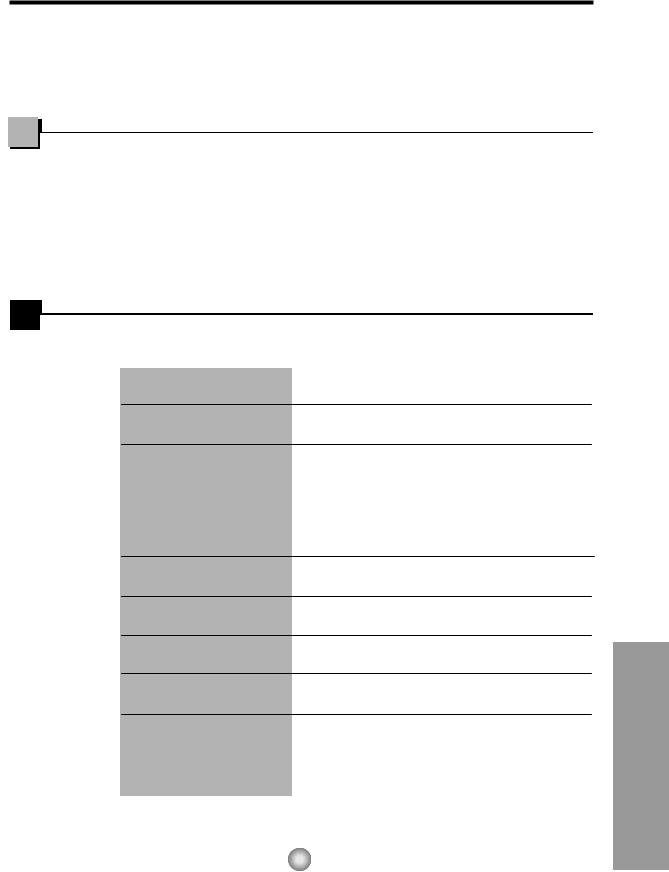
Before you call for service...
Troubleshooting Tips save time and money!
Review the chart below first and you may not need to call for service.
Normal Operation
•You may hear a pinging noise caused by water being picked up and thrown against the condenser on rainy days or when the humidity is high. This design feature helps remove moisture and improve efficiency.
•You may hear the thermostat click when the compressor cycles on and off.
•Water will collect in the base pan during high humidity or on rainy days. The water may overflow and drip from the outdoor side of the unit.
•The fan may run even when the compressor does not.
 Abnormal Operation
Abnormal Operation
Problem |
Possible Causes |
What To Do |
|
|
|
|
|
|
■ The air conditioner is |
• Make sure the air conditioner plug is pushed |
|
|
unplugged. |
completely into the outlet. |
|
Air conditioner |
■ The fuse is blown/circuit |
• Check the house fuse/circuit breaker box and |
|
breaker is tripped. |
replace the fuse or reset the breaker. |
|
|
does not start |
|
||
|
■ Power failure. |
• If power failure occurs, turn the mode control to Off. |
|
|
|
When power is restored, wait 3 minutes to restart the |
|
|
|
air conditioner to prevent tripping of the compressor |
|
|
|
overload. |
|
|
|
|
|
|
■ Airflow is restricted. |
• Make sure there are no curtains, blinds, or furniture |
|
|
|
blocking the front of the air conditioner. |
|
Air conditioner does not cool as it should
■The THERMOSTAT may • Turn the knob to a higher number. The highest not be set high enough. setting provides maximum cooling.
■The air filter is dirty. • Clean the filter at least every 2 weeks.
|
See the Care and Maintenance section. |
■ The room may have been |
• When the air conditioner is first turned on, you need |
hot. |
to allow time for the room to cool down. |
■ Cold air is escaping. |
• Check for open furnace floor registers and cold air |
|
returns. |
|
■ Cooling coils have iced up. |
• See Air Conditioner Freezing Up below. |
|
|
|
Air conditioner |
■ Ice blocks the air flow and |
• Set the mode control at High Fan or High Cool with |
freezing up |
stops the air conditioner |
thermostat at 1 or 2. |
|
from cooling the room. |
|
|
|
|
...service for call you Before
11
